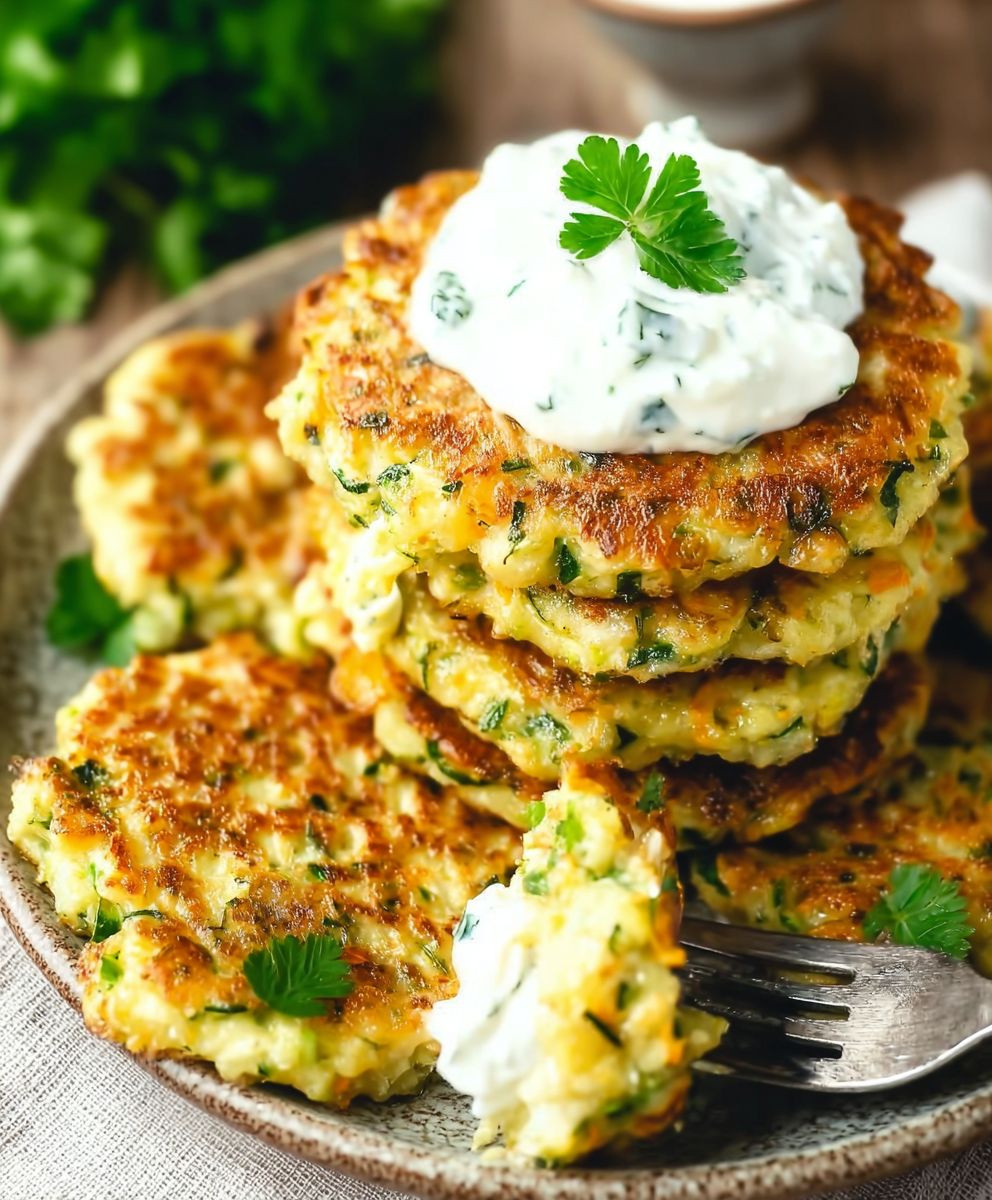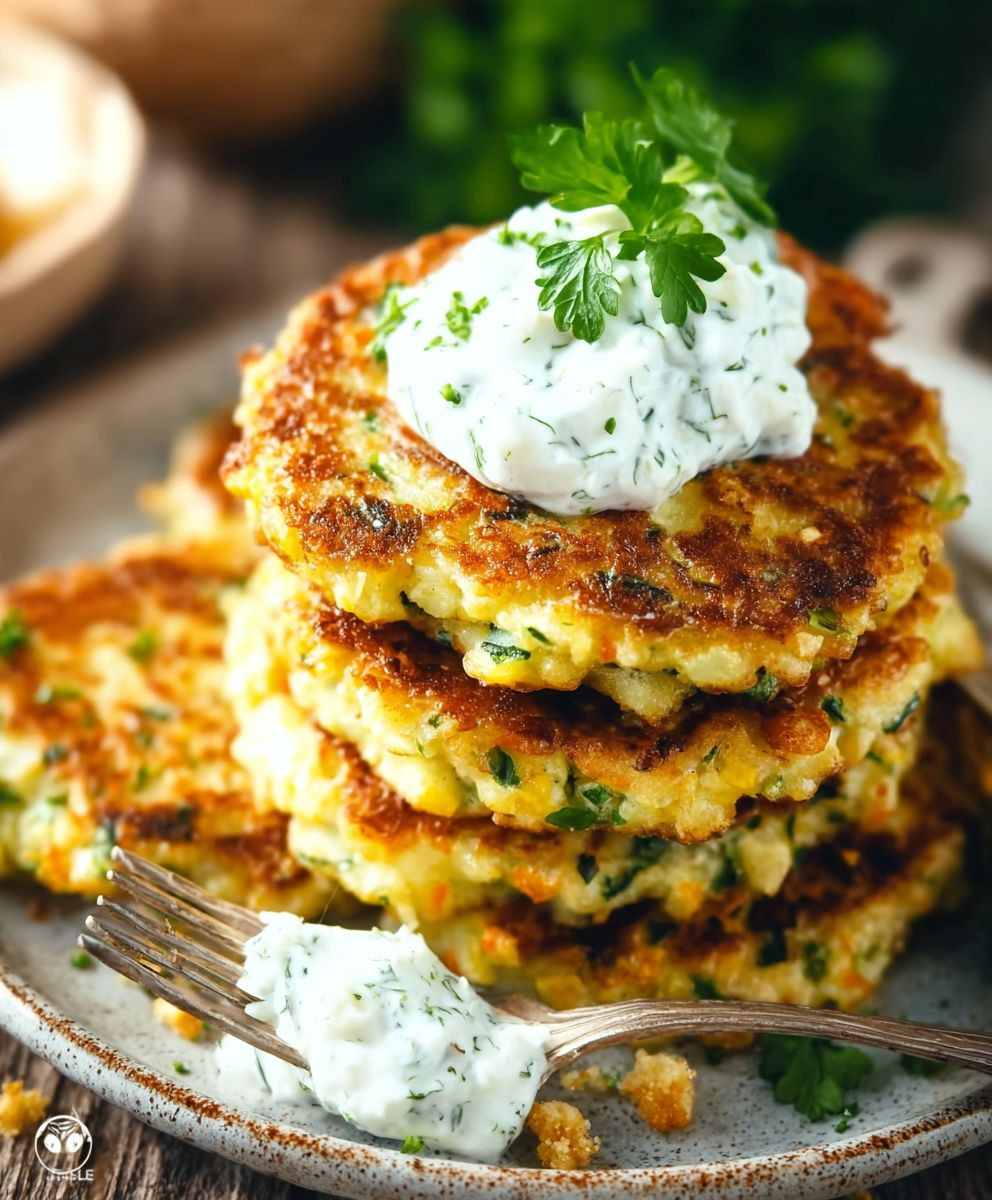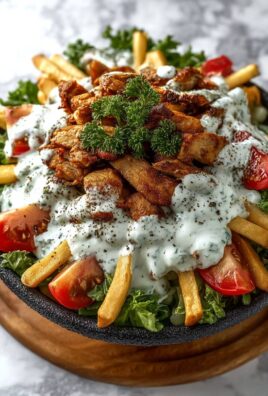Gemüsetaler mit Kräuterquark – schon beim Klang dieses Namens läuft mir das Wasser im Mund zusammen! Kennen Sie das Gefühl, wenn ein Gericht so vielversprechend klingt, dass man es sofort ausprobieren möchte? Genau das ist bei diesen kleinen Köstlichkeiten der Fall. Stellen Sie sich vor: Knusprige, goldbraune Taler, gefüllt mit einer bunten Vielfalt an frischem Gemüse, serviert mit einem cremigen, aromatischen Kräuterquark. Einfach himmlisch!
Gemüsetaler sind weit mehr als nur eine einfache Beilage. Sie sind ein Ausdruck von Kreativität und Vielfalt in der Küche. Obwohl ihre genaue Herkunft schwer zu bestimmen ist, lassen sich ähnliche Zubereitungen in vielen Kulturen finden. Von indischen Gemüse-Patties bis hin zu mediterranen Zucchinipuffern – die Idee, Gemüse in eine handliche, leckere Form zu bringen, ist universell. Und das aus gutem Grund!
Warum sind Gemüsetaler mit Kräuterquark so beliebt? Nun, die Antwort ist einfach: Sie sind unglaublich vielseitig, gesund und unglaublich lecker. Die Kombination aus knuspriger Textur und dem frischen, leicht süßlichen Geschmack des Gemüses ist unwiderstehlich. Der Kräuterquark sorgt für eine cremige, würzige Note, die perfekt dazu passt. Ob als Vorspeise, Beilage, Snack oder sogar als Hauptgericht – diese Taler sind immer eine gute Wahl. Und das Beste daran? Sie sind kinderleicht zuzubereiten und lassen sich wunderbar variieren, je nachdem, welches Gemüse gerade Saison hat. Also, worauf warten Sie noch? Lassen Sie uns gemeinsam in die Welt der Gemüsetaler eintauchen!
Ingredients:
- For the Vegetable Patties:
- 500g mixed vegetables (e.g., carrots, zucchini, potatoes, broccoli), finely grated or chopped
- 1 medium onion, finely chopped
- 2 cloves garlic, minced
- 100g breadcrumbs (plus extra for coating)
- 2 large eggs
- 50g grated Parmesan cheese (optional)
- 2 tablespoons chopped fresh parsley
- 1 tablespoon chopped fresh chives
- 1 teaspoon dried thyme
- ½ teaspoon ground cumin
- Salt and pepper to taste
- Vegetable oil for frying
- For the Herb Quark:
- 250g quark (low-fat or full-fat)
- 2 tablespoons milk or cream (to adjust consistency)
- 2 tablespoons chopped fresh herbs (e.g., parsley, chives, dill)
- 1 clove garlic, minced (optional)
- Lemon juice to taste
- Salt and pepper to taste
Preparing the Vegetable Mixture:
- First, let’s get our vegetables ready. Wash and peel (if necessary) all the vegetables you’ve chosen. I like to use a mix of carrots, zucchini, potatoes, and broccoli for a variety of flavors and textures. You can use a box grater to finely grate them, or if you prefer a chunkier patty, you can finely chop them. The key is to make sure the pieces are small enough to bind together well.
- Now, take your finely chopped onion and minced garlic and add them to the grated or chopped vegetables. The onion and garlic will add a lovely savory flavor to our patties.
- Next, we need to remove some of the excess moisture from the vegetables. This is crucial for preventing the patties from becoming soggy. Place the vegetable mixture in a clean kitchen towel or cheesecloth. Gather the edges of the towel and squeeze out as much liquid as possible. You’ll be surprised how much water comes out! This step is really important, so don’t skip it.
- Once you’ve squeezed out the excess moisture, transfer the vegetable mixture to a large mixing bowl.
Binding the Ingredients:
- Now it’s time to bind everything together. Add the breadcrumbs to the vegetable mixture. The breadcrumbs will absorb any remaining moisture and help the patties hold their shape. I usually use plain breadcrumbs, but you can also use seasoned breadcrumbs for extra flavor.
- Crack the two eggs into the bowl. The eggs will act as a binder, holding all the ingredients together. Make sure the eggs are well incorporated into the vegetable mixture.
- If you’re using Parmesan cheese, now’s the time to add it. The Parmesan will add a lovely salty and savory flavor to the patties. It’s totally optional, but I highly recommend it!
- Add the chopped fresh parsley and chives. These herbs will add a burst of freshness to the patties. You can also experiment with other herbs, such as dill or oregano.
- Season the mixture with dried thyme, ground cumin, salt, and pepper. Be generous with the seasoning, as the vegetables can be a bit bland on their own. Taste the mixture and adjust the seasoning as needed.
- Use your hands or a large spoon to thoroughly mix all the ingredients together until everything is well combined. The mixture should be moist but not soggy. If it seems too wet, add a little more breadcrumbs. If it seems too dry, add a splash of milk or water.
Forming and Coating the Patties:
- Now comes the fun part: forming the patties! Take a generous spoonful of the vegetable mixture and shape it into a patty. I like to make them about 1-2 cm thick and about 7-8 cm in diameter. You can make them any size you like, but keep in mind that smaller patties will cook faster.
- Place the formed patty on a plate lined with parchment paper. Repeat this process until you’ve used up all the vegetable mixture.
- If you want to add an extra layer of crispiness, you can coat the patties in breadcrumbs. Place some breadcrumbs in a shallow dish. Gently press each patty into the breadcrumbs, making sure to coat both sides evenly. This step is optional, but it will give the patties a lovely golden-brown crust.
- Once all the patties are formed and coated (if desired), place them in the refrigerator for at least 30 minutes. This will help them firm up and prevent them from falling apart during cooking. You can even leave them in the refrigerator overnight.
Cooking the Vegetable Patties:
- Heat a generous amount of vegetable oil in a large skillet over medium heat. The oil should be hot enough to sizzle when you add a patty.
- Carefully place the patties in the hot oil, making sure not to overcrowd the skillet. Cook the patties for about 4-5 minutes per side, or until they are golden brown and cooked through.
- Use a spatula to carefully flip the patties over and cook the other side.
- Once the patties are cooked through, remove them from the skillet and place them on a plate lined with paper towels to drain off any excess oil.
- Repeat this process until all the patties are cooked.
Preparing the Herb Quark:
- While the patties are cooking, let’s prepare the herb quark. In a medium bowl, combine the quark, milk or cream, chopped fresh herbs, minced garlic (if using), lemon juice, salt, and pepper.
- Stir everything together until well combined. The milk or cream will help to loosen the quark and make it easier to spread.
- Taste the quark and adjust the seasoning as needed. You can add more lemon juice for a tangier flavor, or more herbs for a more intense flavor.
- Cover the bowl and refrigerate the herb quark until ready to serve. This will allow the flavors to meld together.
Serving the Vegetable Patties:
- Now it’s time to serve our delicious vegetable patties! You can serve them hot or cold, depending on your preference.
- Place the patties on a plate and top with a generous dollop of herb quark.
- Garnish with extra fresh herbs, such as parsley or chives.
- Serve the patties as a main course with a side salad or roasted vegetables. They also make a great appetizer or snack.
- Enjoy! These vegetable patties are a healthy and delicious way to get your daily dose of vegetables. They’re also a great way to use up leftover vegetables. I hope you enjoy this recipe as much as I do!

Fazit:
Ich hoffe, ich konnte euch mit diesem Rezept für Gemüsetaler mit Kräuterquark ein wenig inspirieren! Glaubt mir, diese kleinen Dinger sind einfach der Hammer. Sie sind nicht nur super lecker und gesund, sondern auch unglaublich vielseitig. Die Kombination aus knackigem Gemüse und dem frischen, cremigen Kräuterquark ist einfach unschlagbar. Und das Beste daran? Sie sind wirklich kinderleicht zuzubereiten, selbst wenn ihr keine Küchenprofis seid.
Warum ihr dieses Rezept unbedingt ausprobieren müsst? Nun, abgesehen davon, dass die Gemüsetaler mit Kräuterquark eine fantastische Möglichkeit sind, mehr Gemüse in eure Ernährung einzubauen, sind sie auch perfekt für jede Gelegenheit. Ob als leichter Mittagssnack, als Beilage zum Grillen, als Fingerfood auf Partys oder sogar als Hauptgericht mit einem knackigen Salat – sie passen einfach immer. Und mal ehrlich, wer kann schon einem Teller voller goldbraun gebratener Gemüsetaler widerstehen?
Serviervorschläge und Variationen:
Die Möglichkeiten sind endlos! Ihr könnt die Gemüsetaler warm oder kalt genießen. Warm schmecken sie besonders gut mit einem Klecks extra Kräuterquark oder einem frischen Dip wie Joghurt-Minz-Soße oder einem leichten Tomaten-Relish. Kalt sind sie ideal für unterwegs oder als Teil einer Lunchbox.
Und was die Variationen angeht, lasst eurer Kreativität freien Lauf! Ihr könnt das Gemüse je nach Saison und Geschmack austauschen. Wie wäre es zum Beispiel mit Zucchini und Karotten im Sommer oder mit Kürbis und Pastinaken im Herbst? Auch bei den Kräutern könnt ihr variieren. Probiert doch mal Dill, Schnittlauch, Petersilie oder sogar etwas Zitronenmelisse im Kräuterquark. Für eine extra Portion Würze könnt ihr auch etwas geriebenen Käse (z.B. Parmesan oder Gouda) in den Teig geben. Und wer es gerne etwas schärfer mag, kann eine Prise Chili oder etwas fein gehackte Peperoni hinzufügen.
Eine weitere tolle Idee ist, die Gemüsetaler als Burger-Patties zu verwenden. Belegt sie einfach mit euren Lieblingszutaten wie Salat, Tomaten, Gurken und einer leckeren Soße. So habt ihr im Handumdrehen einen gesunden und leckeren vegetarischen Burger. Oder ihr serviert sie als Beilage zu einem Stück gegrilltem Fisch oder Hähnchen. Die Gemüsetaler mit Kräuterquark passen einfach zu allem!
Ich bin wirklich gespannt, wie euch das Rezept gefällt und welche Variationen ihr ausprobiert. Also, ran an den Herd und lasst es euch schmecken! Vergesst nicht, eure Kreationen und Erfahrungen mit mir zu teilen. Ich freue mich über eure Kommentare, Fotos und Anregungen. Vielleicht habt ihr ja sogar noch einen Geheimtipp, den ihr mit mir teilen möchtet? Lasst uns gemeinsam die Welt der Gemüsetaler erkunden und immer wieder neue, leckere Varianten entdecken!
Also, worauf wartet ihr noch? Probiert die Gemüsetaler mit Kräuterquark aus und überzeugt euch selbst von ihrem unwiderstehlichen Geschmack! Ich bin mir sicher, sie werden euch genauso begeistern wie mich. Viel Spaß beim Kochen und Genießen!
Gemüsetaler mit Kräuterquark: Das einfache Rezept für leckere Taler
Knusprige Gemüsebratlinge mit frischem Kräuterquark – ein leckeres und gesundes Gericht, perfekt als Hauptspeise, Beilage oder Snack!
Ingredients
- 500g gemischtes Gemüse (z.B. Karotten, Zucchini, Kartoffeln, Brokkoli), fein gerieben oder gehackt
- 1 mittelgroße Zwiebel, fein gehackt
- 2 Knoblauchzehen, gehackt
- 100g Paniermehl (plus extra zum Wenden)
- 2 große Eier
- 50g geriebener Parmesan (optional)
- 2 Esslöffel gehackte frische Petersilie
- 1 Esslöffel gehackter frischer Schnittlauch
- 1 Teelöffel getrockneter Thymian
- ½ Teelöffel gemahlener Kreuzkümmel
- Salz und Pfeffer nach Geschmack
- Pflanzenöl zum Braten
- 250g Quark (Magerquark oder Vollfettquark)
- 2 Esslöffel Milch oder Sahne (zum Anpassen der Konsistenz)
- 2 Esslöffel gehackte frische Kräuter (z.B. Petersilie, Schnittlauch, Dill)
- 1 Knoblauchzehe, gehackt (optional)
- Zitronensaft nach Geschmack
- Salz und Pfeffer nach Geschmack
Instructions
- Gemüse vorbereiten: Gemüse waschen, schälen (falls nötig) und fein reiben oder hacken. Zwiebel und Knoblauch fein hacken und zum Gemüse geben.
- Feuchtigkeit entfernen: Das Gemüse in ein sauberes Küchentuch oder Mulltuch geben und so viel Flüssigkeit wie möglich auspressen.
- Binden: Das Gemüse in eine Schüssel geben. Paniermehl, Eier, Parmesan (falls verwendet), Petersilie, Schnittlauch, Thymian, Kreuzkümmel, Salz und Pfeffer hinzufügen. Alles gut vermischen. Die Mischung sollte feucht, aber nicht zu nass sein. Bei Bedarf mehr Paniermehl oder etwas Milch/Wasser hinzufügen.
- Bratlinge formen: Aus der Gemüsemischung Bratlinge formen (ca. 1-2 cm dick und 7-8 cm Durchmesser). Auf ein mit Backpapier belegtes Blech legen.
- Panieren (optional): Die Bratlinge in Paniermehl wenden, um eine knusprigere Kruste zu erhalten.
- Kühlen: Die Bratlinge für mindestens 30 Minuten (oder über Nacht) im Kühlschrank fest werden lassen.
- Braten: Pflanzenöl in einer großen Pfanne bei mittlerer Hitze erhitzen. Die Bratlinge vorsichtig in das heiße Öl geben und von beiden Seiten goldbraun braten (ca. 4-5 Minuten pro Seite).
- Abtropfen lassen: Die fertigen Bratlinge auf einem mit Küchenpapier ausgelegten Teller abtropfen lassen.
- Kräuterquark zubereiten: Quark, Milch/Sahne, gehackte Kräuter, Knoblauch (falls verwendet), Zitronensaft, Salz und Pfeffer in einer Schüssel verrühren. Abschmecken und bis zum Servieren kühl stellen.
- Servieren: Die Gemüsebratlinge mit einem Klecks Kräuterquark servieren. Mit frischen Kräutern garnieren.
Notes
- Die Gemüsesorten können je nach Geschmack variiert werden.
- Für eine vegane Variante können die Eier durch Leinsamen-Eier oder Apfelmus ersetzt werden.
- Die Bratlinge können auch im Ofen gebacken werden (ca. 20-25 Minuten bei 180°C).
- Der Kräuterquark kann auch durch einen anderen Dip ersetzt werden (z.B. Joghurt-Dip oder Hummus).




Leave a Comment